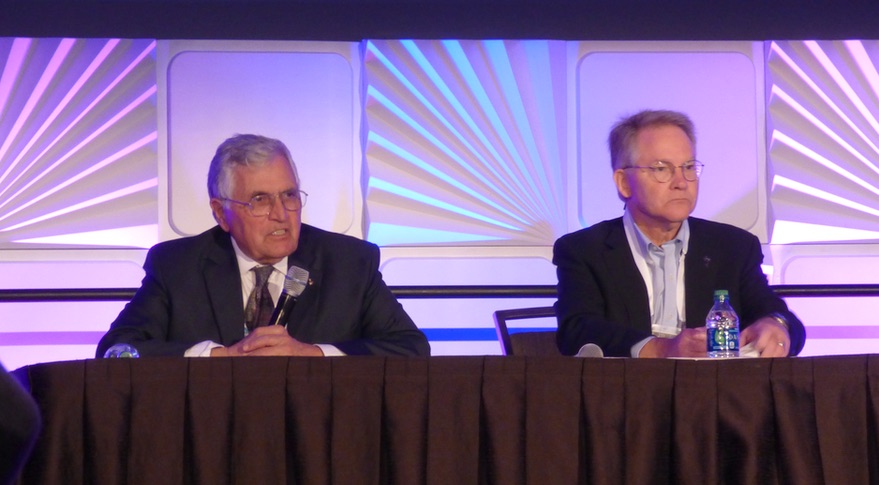Space Council Advisory Group to Study Role of Human Space Exploration Supporting Science

SEATTLE — The advisory group for the National Space Council is looking at ways that NASA's human exploration plans can also support space science, while acknowledging the lack of representation of the scientific community in the group.
Two members of the Users' Advisory Group (UAG) of the National Space Council met with attendees of the 233rd Meeting of the American Astronomical Society here Jan. 9 in the latest of a series of listening sessions held by the group with various space constituencies.
The UAG, established last year as a "think tank" to support the National Space Council, is working on a variety of topics, including examining potential synergies between human space exploration and space science.
"We've been asked to help the Space Council understand and explore the nexus between space science across its various disciplines — astrophysics, heliophysics, planetary science and Earth science — with human exploration in the upcoming era of returning to the moon," said David Thompson, founder and former chief executive of Orbital ATK.
That includes potential applications of the Gateway that NASA plans to develop in cislunar space. The agency has already been looking at potential scientific applications of the Gateway, including hosting a conference on the topic in February 2018. The Space Studies Board also plans to hold a workshop later this year on the role of human space exploration supporting science.
Thompson said the council has asked the UAG "to help them come up with the best ideas and the best understanding of the areas where new scientific missions in all of the space-based fields can be enabled or enhanced by the lunar Gateway."
One such concept relevant to this conference is using the Gateway to assist in the assembly and servicing of future space telescopes. "One of the things that we want to understand from you," he told the astronomers in the conference, "is what is the best thinking about the scientific desirability of such systems and how we can help communicate to NASA what design features ought to be built into the Gateway to make in-space assembly and servicing of those systems most readily accomplished."
Breaking space news, the latest updates on rocket launches, skywatching events and more!
Those telescopes, he added, would likely not operate in the same orbit as the Gateway but rather at the Earth-sun L-2 Lagrange point, like the upcoming James Webb Space Telescope. That location is "right around the corner" from the Gateway in terms of energy, he noted, making it relatively easy to move observatories between L-2 and the Gateway.
"One could imagine, a decade or two from now, a symbiotic relationship between Gateway and very-large-diameter telescopes, being as productive as what we had with the Hubble telescope," he said, which was serviced for nearly two decades by the space shuttle.
During the hour-long meeting, astronomers asked Thompson and Harrison Schmitt, the Apollo 17 astronaut who was the other UAG member present, questions on topics ranging from spectrum management and its effects on radio astronomy to orbital debris.
Some also brought up the lack of representation by the scientific community on the UAG, which is dominated by executives of space companies, former astronauts and leaders of industry groups. "It's incredibly important to have more scientific expertise on the users' committee," noted one attendee.
Thompson acknowledged that was an issue. "I think a number of current members of the group have made that suggestion," he said. "I do think we could do a better job representing all the major users of space if we had a couple of practicing scientists."
Schmitt reiterated concerns he expressed at the last UAG meeting in November that NASA was moving too slowly on its exploration plans. "I think the biggest risk is that things don't move fast enough for the political system to continue its support," he said. The UAG, he said, had a concern "about a sense of urgency to move forward" to maintain public and political support.
He also raised the prospects of competition with other countries in space exploration. "I think time will tell whether the powers that be recognize there is a competition. There certainly is," he argued. "We will see whether the Congress and the administration recognize that there is a competition out there."
"The current government initiative to return the United States to cislunar space and to the moon is the third attempt since Apollo to do so," Thompson said, referring to the earlier Space Exploration Initiative and Vision for Space Exploration. "Not counting this one, we're 0-for-2. So hopefully this time we'll get a hit, and I think there are reasons to believe that we will."
This story was provided by SpaceNews, dedicated to covering all aspects of the space industry.

Jeff Foust is a Senior Staff Writer at SpaceNews, a space industry news magazine and website, where he writes about space policy, commercial spaceflight and other aerospace industry topics. Jeff has a Ph.D. in planetary sciences from the Massachusetts Institute of Technology and earned a bachelor's degree in geophysics and planetary science from the California Institute of Technology. You can see Jeff's latest projects by following him on Twitter.

